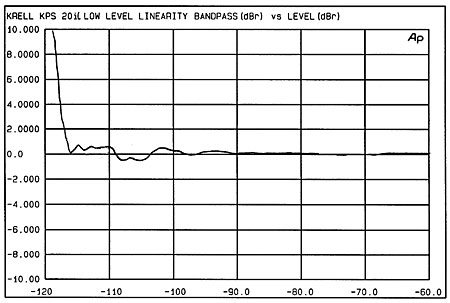| Columns Retired Columns & Blogs |
Krell KPS-20i CD player MC's Measurements
Sidebar 4: MC's Measurements
As a CD player, the KPS-20iL performed very well. It's non-inverting—pin 2 is wired to be positive on the balanced outputs—and has essentially linear phase and zero interchannel phase difference. The Krell's frequency response (fig.1) was essentially flat, lacking the premature HF rolloff of some earlier DSP implementations. With de-emphasis, there was a mild loss of –0.5dB by 16kHz. This will not be very audible.

Fig.1 Krell KPS-20iL, frequency response without de-emphasis (solid line) and with (dashed) (0.5dB/vertical div.).
Channel balance was essentially perfect at ±0.1dB from 20Hz to 20kHz, while very high channel separation was seen, at better than 135dB at low and mid-frequencies, and a still-excellent 111dB by 20kHz. Signal/noise ratios were fine, and an overall dynamic range of 110dB was delivered with full 16-bit code resolution.
Linearity was excellent: the nominal error in replay level at –90.31dB modulation was within ±0.1dB for both channels. Indeed, the linearity graph (fig.2) showed less than ±0.8dB of error right down to –116dB. A dithered, –90dB sinewave (fig.3, bottom) looked marvelously pure, and the corresponding spectrum analysis (fig.3, top) suggested that the Krell was introducing no distortion, even at –118dB relative to full modulation or 0dBFS. These tests were made with a dithered signal; the waveform of a "straight," undithered 16-bit digitally encoded sinewave at –90.31dB can be seen in fig.4 and is as close to perfection as you could wish for. (Comparing figs.3 and 4 reveals how dither in the recording process linearizes 16-bit replay.) Tested for dynamic noise modulation over the –60dB to –100dB range (fig.5), the variation was small, and the overall result was very good.

Fig.2 Krell KPS-20iL, departure from linearity (right channel dashed, 2dB/vertical div.).

Fig.3 Krell KPS-20iL, spectrum of dithered 1kHz tone at –90.31dBFS, with noise and spuriae (top); waveform of dithered 1kHz sinewave at –90.31dBFS (bottom).

Fig.4 Krell KPS-20iL, waveform of undithered 1kHz tone at –90.31dBFS.

Fig.5 Krell KPS-20iL, noise modulation, –60dB (solid) and –100dBFS (dashed) (10dB/vertical div.).
The output stage boasts a very low 12 ohm output impedance. The latter is very powerful, offering up to 5.25V output; it will even drive compatible headphones with the right matching cables. With the unbalanced output level set to a moderate output level of 1V RMS, the 0dBFS distortion results were very close to the full CD specification: eg, –91dB, 1kHz, 0dB modulation. If the output level was increased to the CD-standard 2V, the distortion result worsened to –84dB. This is still very good performance, but reveals the presence of the output amplifier. Set to the 4V output (fig.6), the distortion rose to 0.01% (–80dB) for the unbalanced output, and a little less, –84dB, for the balanced output. These results were both fine and typical of a "CD player used with a preamp."

Fig.6 Krell KPS-20iL, spectrum of 125Hz sinewave, DC–1kHz, at 4V into 100k ohms, balanced (solid) and unbalanced (dashed). Note that the third harmonic is the highest, at –84dB, for the balanced mode; the second harmonic is the highest for the unbalanced mode (10dB/vertical div.).
On reducing the digital data's modulation level by 10dB, the distortion results were at the system limit (–85dB including noise), while the results for dithered tones at –70dBFS (fig.7) were exemplary. One channel, however, did show a hint of 44.1kHz, the primary sample rate, though this was at a pretty negligible –103dB. The KPS-20iL's output was examined for RF products and found to be quite clean—typically –55dB to –60dB in the 1–250MHz region. This is much better performance than earlier Krell digital products.

Fig.7 Krell KPS-20iL, right channel, spectrum of 1kHz sinewave, DC–100kHz, at –70dBFS. The spurious tone at 44.1kHz is not present in the left-channel output (10dB/vertical div.).
The two-tone high-frequency intermodulation spectrum is shown in fig.8. (The uppermost line is not a digital artifact, merely an analog harmonic.) In the audible band, the difference-tone distortion was very low, at –92dB, for 2V output. It was still below –98dB at the –10dB modulation level.

Fig.8 Krell KPS-20iL, HF intermodulation spectrum, 500Hz–100.5kHz, 19+20kHz at 0dBFS (linear frequency scale, 10dB/vertical div.).
The Krell had very good error correction. A 2.5mm gap in the data was cleared without disturbance. Mechanical noise was low, especially with the cover closed. It also proved resilient in the usual shock and vibration tests.
The volume control scale is numbered 0 to 158. A readout of "125" gave 2V output, while "158" delivered the maximum output of 5.25V—enough to drive any power amplifier well into clipping. In my view, however, the volume control software should be revised. Though with practice I could adapt to it, I still found it counterintuitive in that there are some odd-level transitions.
Zero gives just that, zero output, while "1" jumps to just above –64dB referenced to 2V. "2" adds a full 6dB of level, "3" another 6dB, while "4" gets a 3.5dB increment. Though moving from "7" to "8" gives an increase of just +0.7dB, the "8" to "9" transition is 1.5dB. An indicated "10" represents an increase of 22.73dB over the "1" level. Above "20," the increments were typically 0.5dB but still varied. In the range from "126" to "130," for example, the increments ranged from 0.2 to 0.4dB. When it came to numeric jumps of a decade, "40" to "50" represented a level increase of just 1.7dB, while above "50," the decade jumps were typically 2.5dB.
There is really nothing like a smooth-acting, log-based, single-layer control with, say, 0.5dB increments throughout! (See JA's recent comments on the 0.1dB-step resolution of the Mark Levinson No.38S, July '95, p.98.) Although I did get used to it in the end, the Krell's volume-control action is awkward, and from the user's point of view, I can't see any good reason for it to be like this. A larger display would also be nice, offering the ability to read volume level at a fair distance.—Martin Colloms
- Log in or register to post comments



































